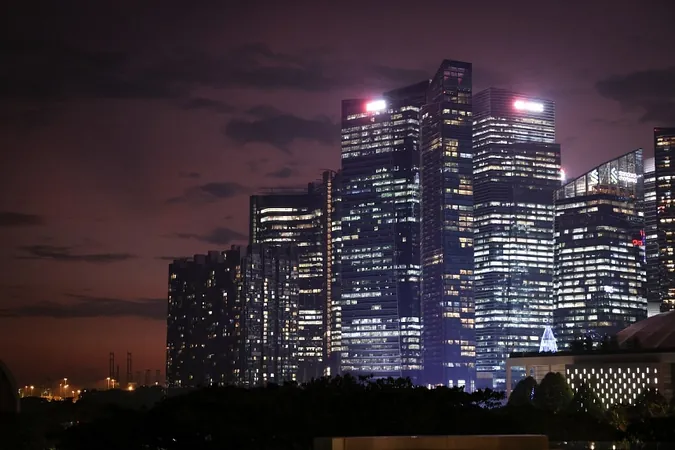
Major Hurdles Ahead in Laos-Singapore Power Deal: Will Clean Energy Become a Reality?
2024-09-23
SINGAPORE – On September 20, Singapore unveiled ambitious plans to double its electricity import capacity through a regional grid, expanding the groundbreaking Laos-Thailand-Malaysia-Singapore (LTMS) power integration project.
This initiative initially sparked excitement due to its promise of clean energy imports from Laos' low-carbon hydropower sources. However, a deeper dive into the project's details raises critical questions about the feasibility of truly renewable energy being transmitted.
The LTMS, heralded in June 2022, aimed to establish a clean energy corridor in Southeast Asia.
Yet discrepancies have emerged regarding how the electricity will actually be sourced in the project's second phase. Notably, a recent inquiry revealed that energy from Malaysia will rely on a mix of generation sources, predominantly stemming from its traditional energy grid, which is significantly coal-dependent.
Recent figures indicate that coal made up over 43% of Malaysia's electricity production in 2023, juxtaposed against natural gas and hydropower.
While the LTMS is driving a hopeful vision of an interconnected ASEAN region, the journey is fraught with challenges.
Southeast Asian nations are racing to decarbonize their economies amidst surging energy demands, yet progress toward a regional grid has been painfully slow due to myriad technical and financial hurdles.
A serious complication arose in December 2023 when Thailand’s then-Prime Minister Srettha Thavisin stated that Thailand would prioritize purchasing Laotian electricity for domestic consumption rather than passing it along to Singapore.
Furthermore, reports in mid-2024 highlighted ongoing disputes regarding how power would be transmitted through Thailand and Malaysia, featuring substantial disagreements about transmission costs.
Laos is eager to position itself as Southeast Asia’s renewable energy powerhouse, exporting significant hydropower volumes to neighboring countries like Thailand and Vietnam.
However, as Thailand seeks to increase its clean power imports from Laos, the struggle to solidify these negotiations continues.
The latest insights into the LTMS extension indicate that without critical regional regulatory alignment and substantial upgrades to existing electricity grids, generating and distributing clean energy will remain a daunting task.
The International Energy Agency has estimated that approximately $21 billion annually will be needed from 2026 to 2030 to modernize the region's electricity infrastructure.
This is a massive undertaking given the diversity of energy policies and infrastructures across ASEAN nations.
Connections among the national power systems of all ten ASEAN countries require significant investments, technical upgrades, and efficient coordination.
In spite of these challenges, the LTMS project has inspired other regional initiatives, such as the Brunei-Indonesia-Malaysia-Philippines (BIMP) power integration project announced in August 2023, aiming for interconnected power grids among these nations.
Notably, Singapore and Malaysia upgraded their shared transmission infrastructure in 2022, setting the stage for 1,000 MW of electricity flow.
Currently, Singapore has a two-year deal for 100 MW of electricity imports from Malaysia, with an agreement to auction up to another 100 MW for Singaporean companies as part of a green energy pilot.
Experts believe that as Malaysia intensifies its renewable energy efforts, the nature of future imports should evolve towards cleaner sources.
aligning with Malaysia’s goal of increasing renewables to provide 31% of its energy needs by 2025 and 40% by 2035.
While the current capacity under the LTMS project may seem relatively small—approximately 200 MW accounts for only 1.6% of Singapore’s generation capacity.
the broader implications reflect the current state of regional clean energy cooperation.
As the ASEAN region grapples with the pressing challenge of transitioning to net-zero emissions, the successful transmission of clean energy via the LTMS hinges on collective regulatory alignment and increased financial support, particularly from the private sector.
Are we witnessing the dawn of a new era in clean energy for Southeast Asia, or will these ongoing disputes and infrastructural challenges prevent a sustainable future? Only time will tell as the world watches this ambitious regional undertaking unfold.


 Brasil (PT)
Brasil (PT)
 Canada (EN)
Canada (EN)
 Chile (ES)
Chile (ES)
 España (ES)
España (ES)
 France (FR)
France (FR)
 Hong Kong (EN)
Hong Kong (EN)
 Italia (IT)
Italia (IT)
 日本 (JA)
日本 (JA)
 Magyarország (HU)
Magyarország (HU)
 Norge (NO)
Norge (NO)
 Polska (PL)
Polska (PL)
 Schweiz (DE)
Schweiz (DE)
 Singapore (EN)
Singapore (EN)
 Sverige (SV)
Sverige (SV)
 Suomi (FI)
Suomi (FI)
 Türkiye (TR)
Türkiye (TR)